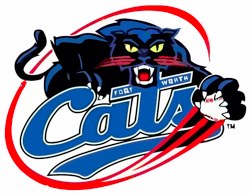 We could set yet another revival of the Fort Worth Cats, as the team’s former home — LaGrave Field — is rescued from the wrecking ball by a land swap organized by a local nonprofit.
We could set yet another revival of the Fort Worth Cats, as the team’s former home — LaGrave Field — is rescued from the wrecking ball by a land swap organized by a local nonprofit.
Houston-based Panther Acquisition Partners is swapping the 8.1 acre site hosting the ballpark for a larger, 15.3-acre site now controlled by the Tarrant Regional Water District. The ballpark site will then be leased to Save LaGrave Foundation, which will repair and run the ballpark, contingent on paying $4 million immediately and later paying $3 million in prepaid rent. The 40-year lease also calls for the Save LaGrave Foundation to spend $2 million in capital improvements over the next three years, as well as pick up all ballpark costs, including taxes and utilities.
The story of LaGrave Field goes back to 1926, when the original ballpark opened in the midst of a working-class neighborhood. The original Fort Worth Cats played at the first iteration of LaGrave Field, owned most of that time by the Brooklyn Dodgers and run as a Dodgers farm team, with greats like Duke Snider and Maury Wills spending time there and Rogers Hornsby coaching there. Fort Worth was a mainstay in the Texas League and regularly led that circuit in attendance. But the success ended, and the Dodgers sold LaGrave Field and the Cats to the Chicago Cubs, in the deal that gave the Dodgers the old PCL Los Angeles Angels, Wrigley Field and the rights to the Los Angeles market. By 1964 the Cats were gone, moved to a new ballpark on the turnpike that eventually became home to the Texas Rangers. The ballpark, forgotten and unused, was torn down in 1967.
The current LaGrave Field — such as it is — was reborn in 2001 when local businessman Carl Bell rebuilt a new ballpark on the site of the old one for the 2002 season. First, they could determine where the original foul poles stood so they could map the foul lines and match the original home-plate location. Though the original ballpark had been torn down, the job was done on the cheap, so the original dugouts and walkways were still there, buried under some rubble. (They were occupied mainly by snakes — a challenge to the crew digging them out.) Early on the decision was made to keep the original dugouts, but they were converted into unique seating areas with their own entrances. Bell eventually lost control of the ballpark to his lender, who then sold it to Vandals have done a lot of damage to this later LaGrave Field. Here a look at our visit to LaGrave Field when it was a working facility.
Scott Berry, formerly owner of multiple American Association teams, is a key player in this process, both in launching the nonprofit and running the new for-profit Fort Worth Cats. There’s certainly hope the new LaGrave Field could open Where the Cats end up remains to be seen: the American Association may be a possibility, as could be the new independent Southwest League. From the Fort Worth Star-Telegram:
“We are keeping our options open,” Berry said. “We want to play in the best league. Our ultimate goal is to play in a Texas-centric league. We feel very strongly that there needs to be a league with multiple Texas teams and right now that doesn’t really exist.”…
The Dallas-based Southwest League will begin play in 2019 with teams in Waco, Dallas, Royse City and Joplin, Mo., with two more cities to be named, according to Mark Schuster, former owner of the Grand Prairie AirHogs.
“We certainly have an interest in being in Fort Worth,” Schuster said. “We explored the possibility three or four years ago, but it was on the back burner then.”
RELATED STORIES: LaGrave Field Suffering Through Years of Neglect; Sale of LaGrave Field finally goes through; Bell files bankruptcy, preventing LaGrave Field foreclosure
